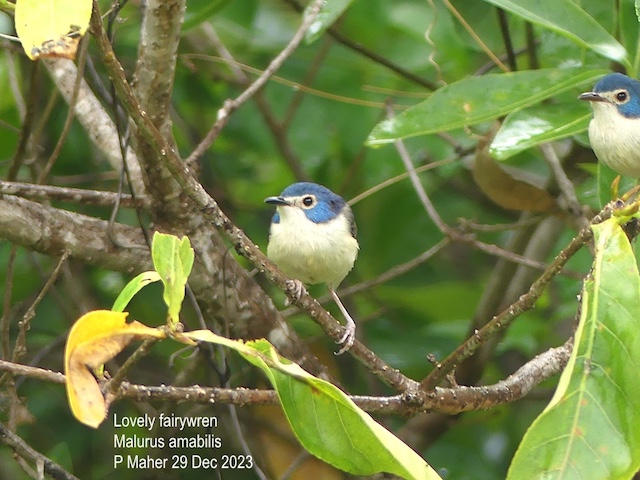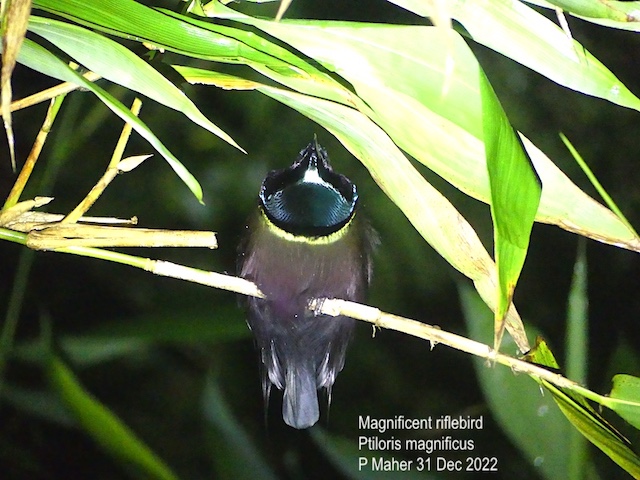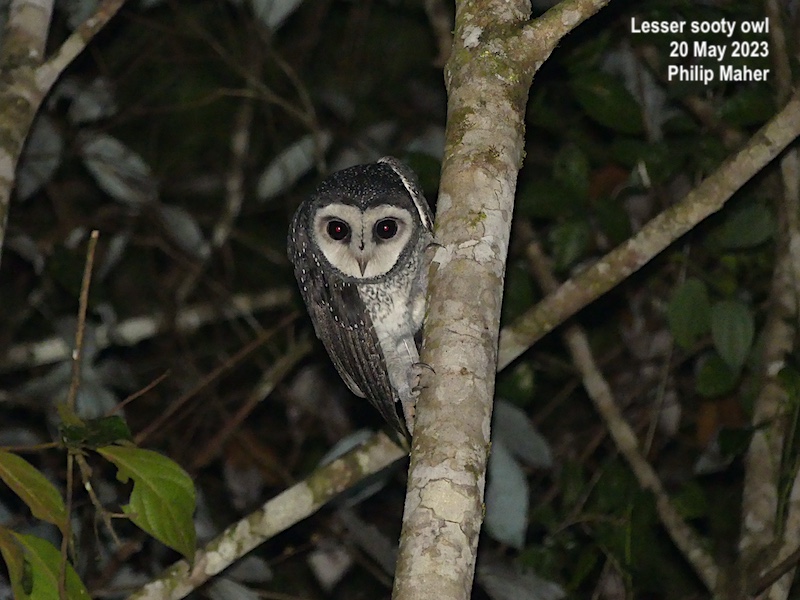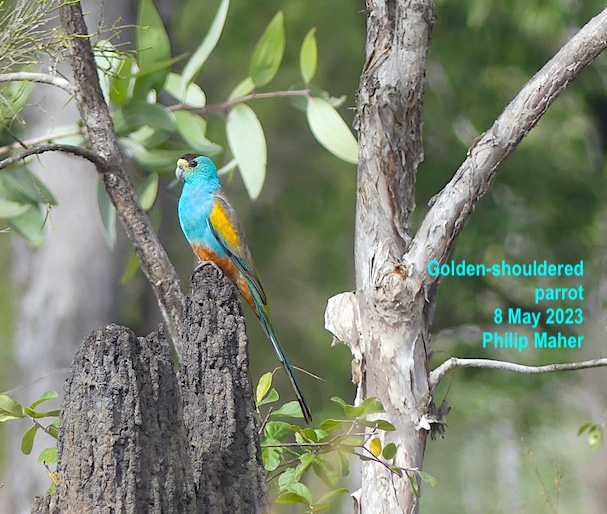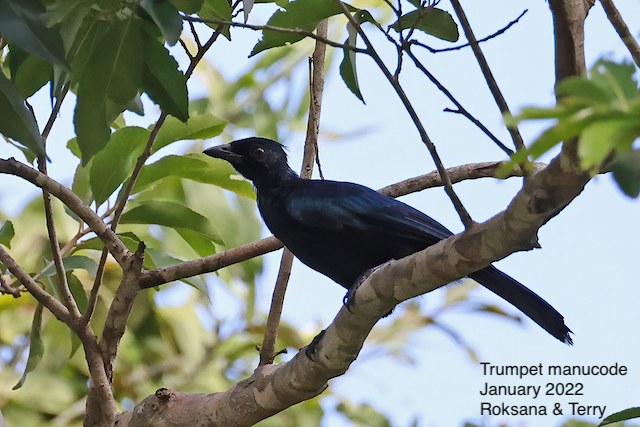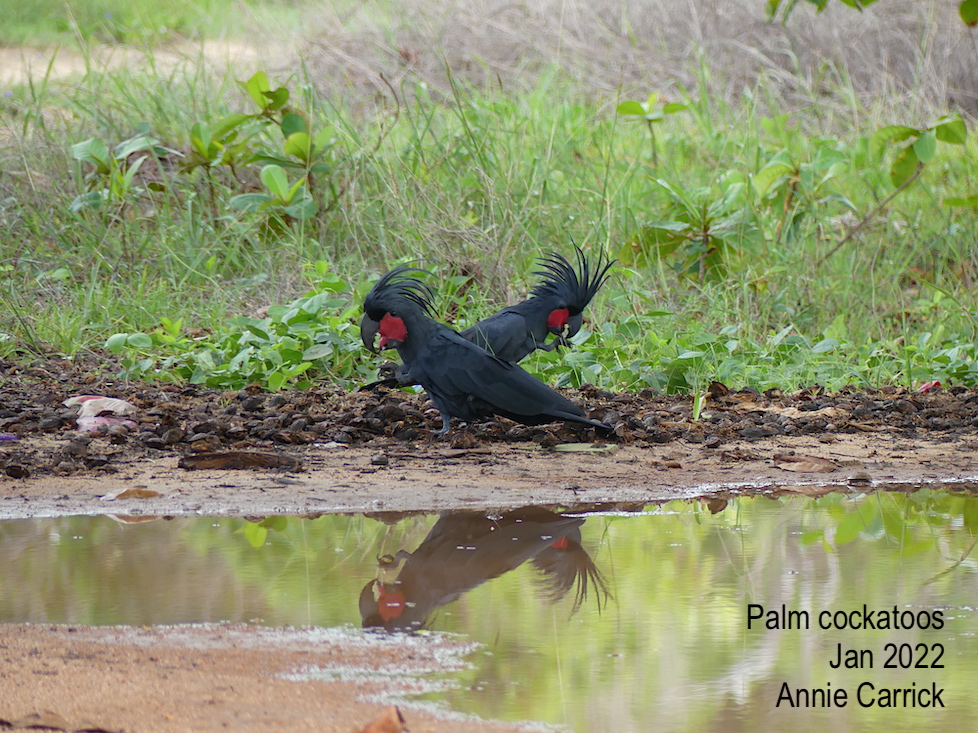Far North Queensland
Atherton Tablelands and Kutini-PayamuI (Iron Range National Park) birding tour
21 May to 3 June 2024
(return to Cairns morning 5 June 2024 optional)
Australian Ornithological Services Pty Ltd
www.philipmaher.com
Part 1 Pre-tour day 21 May 2024
Atherton Tablelands to Kingfisher Park
21 May to 26 May 2024
Part 2 Kingfisher Park to Iron Range NP
26 May to 3 June 2024
Post-tour we head back to Archer River 3 June — Kingfisher Park 4 June— Cairns 5 June for those opting to accompany us back to Cairns.
21 May 2024
Pre-tour night
Overnight: Cairns
22 May 2024
Day 1
We start in Cairns and spend most of the first day birding the parks and gardens for lowland species such as little kingfisher, yellow-bellied sunbird, double-eyed fig-parrot, yellow oriole and varied triller. We'll also bird the Cairns foreshore for over-wintering migratory waders and other waterbirds. There's a chance for beach stone-curlew and nearby mangroves might produce mangrove robin and collared kingfisher. We'll head up to the Atherton Tablelands for a two-night stay in the Lake Eacham area.
Overnight: Chambers Rainforest Lodge
23 May 2024
Day 2
We'll spend the day birding pockets of rainforest for the Atherton endemics on the Tablelands. Highlights today could include golden and tooth-billed bowerbirds, grey-headed robin, Bower's shrike-thrush, Victoria's riflebird, Atherton scrubwren, mountain thornbill, Macleay's and bridled honeyeaters and southern cassowary. We'll spotlight for lesser sooty owl and Lumhotz's tree-kangaroo and assorted possums.
Overnight: Chambers Rainforest Lodge
24 May 2024
Day 3
Lake Eacham to Kingfisher Park.
We’ll bird around Chamber’s Lodge this morning, which is often good for species like pied monarch, yellow-breasted boatbill, spotted catbird, Victoria’s riflebird, Bower’s and little shrike-thrushes, double-eyed fig-parrot, wompoo fruit-dove, white-headed pigeon and barred cuckoo-shrike. Driving around the Tablelands we could come across bush stone-curlew, sarus crane, brolga, grey goshawk, Pacific baza and square-tailed kite. We usually lunch over at Mt Hypipimee, which will give us another opportunity for golden and tooth- billed bowerbirds and southern cassowary — if we are lucky. Nearby dry forest could produce little and scaly-breasted lorikeets, eastern yellow robin, crested shrike-tit and the so-called Herberton (fuscus) honeyeater. On the drive over to Julatten we should see our first red-tailed black-cockatoos.
Overnight: Kingfisher Park25 May 2024 Note: 15 April 2024 Update The bridge on Mt Lewis has not been rebuilt after last season's Wet Season collapse so heading to Mt Lewis is unlikey to happen. We will make other plans for this day.
Day 4
Heading up to Mt Lewis this morning. As well as being a good backup location for any species missed in the Malanda area, it's particularly good for chowchilla, Atherton scrubwren and fernwren as well as golden and tooth-billed bowerbirds. Kingfisher Park gives us opportunities for red-necked crake, blue-faced parrot-finch, pied monarch and yellow-breasted boatbill. Spotlighting here could give us striped possum and Papuan frogmouth.
Overnight: Kingfisher Park
26 May 2024
Day 5 Kingfisher Park/Mareeba areas.
This morning Trisha will transfer any participants who are only doing the Atherton leg of the tour back to Cairns and collect clients who are only doing the Iron Range leg of the tour.We’ll bird some of the drier forest and vine scrub back towards Mareeba today, hoping to connect with species like lovely fairywren, scarlet, white-throated, cryptic and yellow-spotted honeyeaters, northern fantail, fairy gerygone, grey whistler, Gould’s little bronze-cuckoo and white-browed robin. In the afternoon we’ll most likely bird around Kingfisher Park, perhaps having another try for the elusive red-necked crake and any other rainforest birds still eluding us.
Overnight : Kingfisher Park.
Part 2. Iron Range birding tour
The rainforest of Iron Range on Cape York Peninsula is one of the most important areas for endemic birds in Australia with around sixteen species, which, in terms of mainland Australia, only occur there. It is also a great place to see many northern Queensland rainforest species.
The dry woodland and riverine forest on our way up Cape York from Cairns presents opportunities to see black-backed butcherbird and golden-shouldered parrot and we have a chance of red goshawk and many other woodland birds.
We run this tour in the dry season when it is cooler and birding conditions less challenging. What we'll miss are the wet season migrants from PNG: red-bellied pitta, black-winged monarch and buff-breasted paradise kingfisher. (Note, we saw the monarch in 2019, 2021, 2022 and 2023 and amazingly, the buff-breasted paradise kingfisher in 2021 – perhaps late staying rather than overwintering).There are great nocturnal species to be seen on this tour, both mammal and bird, and we'll spotlight on several nights.
27 May 2024
Day 6 Kingfisher Park to Musgrave ( ~400kms)
An early start this morning as we make our way up Cape York. There are plenty of good birds to be seen along the way. North of Mt Carbine we might be lucky enough to see our first back-throated finches, as well as double-barred finches and squatter pigeons (red-eyed form). Other birds about here include the distinctive black form of brown treecreeper, pale-headed rosella, great bowerbird, grey-crowned babbler and apostlebird. At our lunch stop in Laura we should see our first black-backed butcherbirds. After lunch we’ll head up through Lakefield NP, one of the best national parks in Australia for birding with its variety of habitats. Around the melaleuca swamps we will search for the white-bellied crimson finch, which has a very limited range. Honeyeaters often abound in this area and we could see banded, brown, blue-faced, white-throated, rufous-banded, bar-breasted, brown-backed, yellow and yellow-tinted. Red-backed fairywrens should also delight us. The park is good for raptors and we have a chance for spotted and swamp harriers, black-breasted buzzard and square-tailed kite. Australian bustards could also be encountered. Around the extensive wetlands in the park, we might see brolga, sarus crane, jabiru and magpie-goose and a host of other waterbirds.
Overnight: Musgrave RH
28 May 2024
Day 7
Musgrave/Lakefield area.
This morning we head south to Artemis Station. Artemis contains the only remaining accessible population of the endangered golden-shouldered parrot. With help from Sue Shepherd, the owner, we should be able to track them down. Other species we could encounter here include red-browed pardalote, masked finch (white-eared form), white-throated gerygone, leaden flycatcher and cicadabird. We’ll head back to Musgrave for lunch and a break. In the afternoon we’ll head east to Lakefield NP where we will have dinner in the park before spotlighting our way back to Musgrave. On our way out we’ll search an area of forest where red goshawk sometimes nests. We have occasionally seen the beautiful, striated form of varied sittella in this area and golden-backed honeyeater. Spotlighting on Nifold Plain, we have a chance for barking owl, eastern barn and eastern grass owls, red-chested buttonquail and spotted nightjar, as well as various reptiles including black-headed python.
Overnight: Musgrave Roadhouse
29 May 2024
Day 8 Musgrave RH to Archer River RH
This morning we’ll head back out to Lakefield NP, perhaps searching for red goshawk again if we have not been successful previously. Around the melaleuca swamps we have more chances for bar-breasted and rufous-banded honeyeaters and lemon-bellied flycatcher. Out on Nifold Plain we could have a try for zitting cisticola if conditions are suitable. Also possible out here is Australian pratincole, Horsfield’s bushlark and various raptors including spotted harrier and black-breasted buzzard. At a swampy area on the plain, we have a chance for the Cape York race of star finch, which has a very limited distribution. This area is often good for black-throated finches as well as brush cuckoo, jacky winter, forest kingfisher and sometimes restless flycatcher. We’ll have lunch back at a beautiful lily lagoon with plenty of waterbirds before driving on to Archer River.
Overnight: Archer River Roadhouse.30 May 2024
Day 9 Archer River RH to Lockhart River.
Before we leave Archer River, we’ll check out the wetland out the back that sometimes has spotted whistling duck breeding on it. Plumed whistling duck and radjah shelduck could also be present. On the drive into Iron Range, the main species we will be looking for will be the white-streaked honeyeater, which resides in the heathland where there are lots of flowering grevilleas.
Raptors such as square-tailed kite and black-breasted buzzard and peregrine falcon are sometimes seen on the drive in. We will arrive at Iron Range after lunch and begin our task of finding the Cape York endemics. Species likely this afternoon could include eclectus parrot, frill-necked monarch, tropical scrubwren, tawny-breasted honeyeater and magnificent riflebird.
Overnight: Lockhart River Cabins31 May, 1 & 2 June 2024
Days 10, 11 & 12 Lockhart River/Iron Range/Portland Roads.
We will spend the next three days birding the rainforest and the adjacent woodlands to seek out the Cape York endemics. Other habitats we will visit if time allows will be the mangroves and bay at Portland Roads and the ocean beach at Lockhart River township. Various other melaleuca swamps about Lockhart River and the STW will be visited. On a couple of occasions, we’ll drive down Portland Roads for dinner at the cafe and spotlight our way back home.Our main target birds will be the Cape York endemics: marbled frogmouth, yellow-billed kingfisher, palm cockatoo, red-cheeked parrot, eclectus parrot, double-eyed fig-parrot (race marshalli), black-eared catbird, fawn-breasted bowerbird, green-backed honeyeater, white-streaked honeyeater, tawny-breasted honeyeater, graceful honeyeater, tropical scrubwren, black-winged monarch, frill-necked monarch, trumpet manucode, magnificent riflebird, white-faced robin, yellow-legged flycatcher and northern scrub-robin.
It is also a good place to see other desirable species including Australian brush turkey (race purpureicollis), lesser frigatebird, Pacific baza, grey goshawk, wompoo fruit-dove, superb fruit-dove, rose-crowned fruit-dove, Gould’s little bronze-cuckoo, chestnut-breasted cuckoo, masked owl, Papuan frogmouth, large-tailed nightjar, noisy pitta, lovely fairywren, fairy gerygone (race personata), yellow-breasted boatbill, barred cuckoo-shrike, white-eared monarch, shining flycatcher, white-browed robin and red-browed finch (race minor).
Desirable mammals up there include spotted cuscus and grey cuscus and a host of other small mammals.
It is also good for reptiles including saltwater crocodile, amethystine python, water python and emerald python to name a few. Not to forget a host of beautiful butterflies if the weather is right.
3 June 2024
Day 13 Lockhart River to Archer River.
We will spend the morning birding the Iron Range area for any species still missing — there is bound to be something! After lunch, for those who have opted to catch a ride back with us, we will make our way to Archer River.
Overnight: Archer River Roadhouse.4 June 2024
Day 14 Archer River to Kingfisher Park.
Mostly a driving day with a few stops for birding. We often see various honeyeaters including rufous-throated and sometimes cicadabird at the river at Coen. Bustards are usually seen somewhere as well as brolga and sarus crane. We could pick up square-tailed kite or buzzard, and maybe even red goshawk back near Musgrave if we are still missing it. Red-backed kingfisher and black-faced woodswallow are often on the power lines at Lakelands. Dingos could also be seen on the drive.
Overnight: Kingfisher Park.5 June 2024
We return to Cairns after an early breakfast the next morning.For those choosing to fly back to Cairns, there are flights from Lockhart River every week day with Skytrans.
Information
Cost part 1, $3,750.00 AUD, single supplement: $455.00
Cost part 2: $5,680.00 AUD, single supplement: $730.00
Cost for part 1 & 2 combined: $9,430.00 AUD
Single supplement if doing both sections: $1,185.00
Part 1 costs includes accommodation from pre-tour night in Cairns to day 4 at Kingfisher Park. All meals from dinner on pre-tour night to breakfast on day 5, transport, park entrance fees etc and transfer back to Cairns if not doing part 2.
Part 2 costs includes accommodation from day 5 at Kingfisher Park to day 12 at Lockhart River, all meals from dinner on day 5 to breakfast on day 13, transport, park entrance fees etc. Transport Cairns to Kingfisher Park on day 5 for those doing only part two of this itinerary (note: participants need to arrive in Cairns by 2.30 pm).
The cost does not include the flight back to Cairns. Participants are welcome to catch a ride back to Cairns with Philip and Patricia. We will overnight at Archer River RH (3 June 2024) and Kingfisher Park (4 June 2024) before arriving back in Cairns on the morning of 5 June 2024. Participants pay for the own accommodation and dinners on the 3rd and 4th June . Please discuss this option with Patricia.
Flights from Lockhart River to Cairns weekdays: http://www.skytrans.com.au/
This tour is limited to six participants. Travel will be by two late-model Landcruisers.
